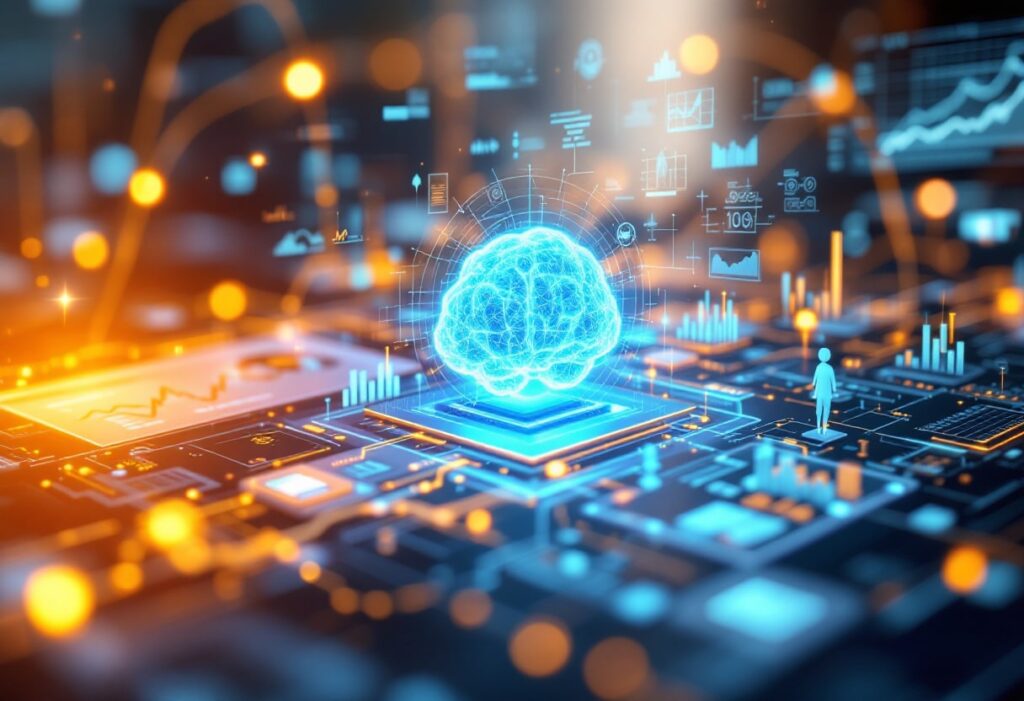Artificial intelligence (AI) has revolutionized the development and product strategies in various industries, transforming traditional processes into advanced and highly optimized systems.
Thanks to AI, companies can now analyze large volumes of data in real time, forecast consumer trends, adapt products to customer expectations and reduce the risks associated with new product launches. These advances help organizations create products that are not only innovative, but also respond precisely to the needs and demands of today's marketplace.
In this article, we will explore how AI can improve every stage of the product development process, from the identification of market opportunities to resource optimization and cost reduction. We will see how companies can leverage these technologies to maximize the success of their products and stay ahead in a highly competitive environment.
What are the strategies of a product?

Artificial intelligence (AI) has transformed product strategies, enabling companies to make more informed and accurate decisions throughout a product's lifecycle. Thanks to AI, product strategies can continuously adapt based on real-time data, consumer preferences and market trends. These are some of the key product strategies powered by AI:
- Identification of market opportunitiesAI makes it possible to analyze large volumes of data to detect consumption patterns and unmet needs in the market. This strategy helps companies to identify niches and segments that could be exploited, designing products that respond directly to specific and emerging demands.
- Product customizationWith the ability to analyze individual preferences, AI enables the creation of highly personalized products that match each customer's tastes and needs. From design recommendations to adaptive features, this personalization strategy increases the relevance of the product for each user, enhancing their experience and loyalty.
- Design optimization and prototypingAI accelerates the design and prototyping process by enabling data-driven virtual simulations and testing. This strategy allows companies to test multiple versions of the product, detect areas of improvement and fine-tune the design before launching it to market, saving time and resources.
- Trend forecastingBy analyzing consumer data and behavioral patterns, AI helps forecast future trends, enabling companies to adapt their products in time to stay ahead of the curve. This strategy ensures that products are aligned with market expectations and changes, enhancing their long-term success.
- Product life cycle optimizationAI facilitates analysis of product performance at each stage of the product lifecycle (introduction, growth, maturity and decline). Using real-time usage data and feedback, companies can make targeted adjustments that prolong product relevance and profitability, adjusting pricing, features or marketing campaigns as needed.
- Cost reduction through automationAI enables the automation of repetitive tasks in product development, optimizing resources and reducing production costs. This strategy allows companies to maintain high quality products and compete on price, improving operational efficiency without sacrificing user experience.
Ready to take your business to the next level? Request a demo of our AI solutions at ENIGMIA
With these strategies, companies can develop products that not only meet current consumer expectations, but are also designed to adapt quickly to market changes. AI, therefore, becomes an essential driver for designing and managing successful products and maintaining a competitive advantage in the marketplace.
Identification of market opportunities through AI

Before the new product development process begins, it is crucial to understand whether there is demand in the market and what consumers' unmet needs are. AI makes it possible to comprehensively analyze consumer behavioral data, preferences and buying trends to identify market opportunities.
Through machine learning algorithms, AI can detect behavioral patterns and emerging needs, enabling companies to discover market niches and respond with products that meet specific demands.
2.1 How market opportunity analysis works
- Big data analysisAI allows you to process data from multiple sources, such as social networks, purchase histories, market research and more, to better understand consumer preferences and demands.
- Pattern detectionAI algorithms identify patterns and trends in consumer data, revealing insights into user preferences and areas of opportunity.
- Prediction of future needsAI can foresee changes in consumer trends, helping companies develop products that align with future demands.
Examples of use
Fashion companies, for example, use AI to identify emerging style patterns and forecast the next season's trends. This allows them to design collections that will have a high probability of market success. In the technology industry, companies can analyze data on functionality and design preferences to anticipate features that will be valued in future devices.
3. Optimization of design and prototyping processes.

AI plays a crucial role in the product design and prototyping phase. Thanks to data-driven simulation and prototyping capabilities, companies can test different versions of a product before investing in its manufacture. This significantly reduces the time and resources required at this stage, accelerating development and avoiding costly mistakes.
3.1 Use of AI in design and simulation
- Simulation of characteristicsAI makes it possible to simulate how certain features of a product will work in the real world, anticipating problems or areas for improvement.
- Rapid prototypingAI can generate prototypes in less time, with features that match market preferences.
- Real-time feedbackAI can analyze feedback from prototypes and make adjustments automatically, optimizing the design for wider market acceptance.
Examples of applications
In the automotive industry, AI is used to simulate the performance of new vehicle designs under different conditions. This allows engineers to improve designs before building a physical prototype. In electronics, AI enables companies to test different product configurations and optimize device features based on consumption data, reducing design errors and speeding up development time.
4. Customization and adaptation of the product to the customer

AI enables companies to design products that are specifically tailored to each customer's needs. By analyzing behavioral and preference data, AI systems can personalize the product or recommend adjustments in real time to make the product relevant to each user. This personalization is especially relevant in industries such as fashion, technology and food, where consumers are looking for products that align with their tastes and lifestyles.
▶ You may be interested in: How are audience levels measured?
How are audience levels measured?
4.1 Product customization through AI
- Customer preference analysisAI analyzes customer preferences and behavioral data to understand individual customer needs.
- Real-time adaptationAI: Through machine learning algorithms, AI adapts the product or its recommendation according to the customer's profile and preferences.
- Improved customer experienceCustomization increases customer satisfaction and loyalty, as they receive a product aligned with their tastes and needs.
Examples of use
In the fashion sector, some companies use AI to personalize the shopping experience, recommending products based on previous shopping styles and fashion preferences. In technology, electronics companies offer products that can be configured to the user's specifications, providing a unique and personalized shopping experience.
5. Trend forecasting and continuous adjustments

AI also enables companies to anticipate market trends and make continuous adjustments to their products to stay relevant. By analyzing large volumes of consumer data and using predictive algorithms, AI can help companies anticipate market trends and make continuous adjustments to their products to stay relevant. IA can identify changes in consumer preferences before they become widespread. This enables companies to adjust their products in real time, responding to emerging needs and maintaining a competitive advantage.
5.1 Use of AI in continuous prediction and adjustment
- Trend forecastingAI algorithms analyze market data to identify emerging trends and forecast changes in consumer preferences.
- Quick settingsAI makes it possible to adjust product features according to market response, while maintaining their relevance in the product life cycle.
- Constant feedbackAI systems receive real-time feedback, enabling companies to make improvements based on customer response.
Examples of use
Consumer goods companies use AI to predict changes in buying habits and adjust their products or marketing campaigns. In the food industry, AI makes it possible to identify and adjust products according to consumers' rapidly changing health and wellness preferences.
6. Reduced costs and improved development efficiency.

AI not only improves product development in terms of customization and precision, but also helps reduce costs by optimizing resources. Through data analysis and task automation, companies can reduce the resources and time needed in research and development, minimizing risks and optimizing each phase of the process.
6.1 Benefits of AI on development efficiency
- Resource optimizationAI enables more accurate planning, maximizing the use of available resources.
- Automation of repetitive tasksAI automates tasks that previously required human intervention, speeding up development and reducing errors.
- Simulations and predictive modelsAI enables virtual simulations and tests, minimizing the cost of materials and physical prototypes.
Examples of use
In the pharmaceutical sector, AI enables simulations of laboratory tests, reducing the cost of research and development of new drugs. In the manufacturing industry, AI helps optimize the production chain, reducing manufacturing time and costs by analyzing efficiency at each stage of the process.
In short
Integrating artificial intelligence into product development offers companies a significant competitive advantage. From identifying market opportunities to optimizing resources and product customization, AI enables greater precision and adaptability, helping companies respond effectively to consumer and market demands.
Companies that leverage AI for product development not only improve the efficiency of their processes, but also succeed in designing products that are more responsive to individual customer needs. AI offers advanced tools that transform product development into a more efficient, agile and cost-effective process, positioning companies at the forefront of innovation in a constantly evolving market.
Discover how Enigmia can transform your product strategy and help you lead in innovation
ENIGMIA is a leader in artificial intelligence solutions applied to communication and strategic product development.. Through an approach based on Big Data and behavioral analytics, we enable companies to identify market opportunities, customize products and adapt in real time to emerging trends.
With advanced AI tools, ENIGMIA optimizes every phase of development, reducing costs and maximizing efficiency to keep companies ahead in a competitive environment.



